External links
| Characters | |
|---|---|
| Films |
|
| TV series | |
| Operas |
|
| Ballets |
|
| Musicals |
|
| Music |
|
| Video games | |
| Related | |
| The Hunchback of Notre Dame | |
|---|---|
| Directed by | Geoff Collins |
| Written by | Victor Hugo (novel) Eddy Graham |
| Based on | The Hunchback of Notre Dame by Victor Hugo |
| Produced by | Tim Brooke-Hunt |
| Starring | Tom Burlinson Angela Punch McGregor Ron Haddrick |
| Edited by | Eddy Graham Caroline Neave |
| Music by | Wilfred Lehmann |
| Distributed by | Image Entertainment (United States) The Rank Organisation (United Kingdom) |
Release dates |
|
Running time | 52 minutes |
| Countries | Australia United States |
| Languages | English French Spanish |
The Hunchback of Notre Dame is a 1986 Australian/American fantasy animated film and an adaptation of the 1831 novel of the same name by Victor Hugo.
Claude Frollo is attempting alchemy, but his thoughts of Esmeralda, a Roma dancer, hinder his concentration. He informs Quasimodo, his hunchbacked and deaf servant, that he needs him to assist in kidnapping Esmeralda. In the Paris streets is the poet Gringoire, who also pines for Esmeralda, and laments his dilemma through poetry. Esmeralda herself passes by, and Quasimodo tries to kidnap her under Frollo's orders. Gringoire tries to save her, but is knocked to the ground instead. Esmeralda is successfully rescued by Captain Phoebus, who has the hunchback arrested, while Frollo escapes. Esmeralda takes a liking to Phoebus, and remarks on the beauty of his name when he leaves.
Gringoire is chased by faux cripples into the Court of Miracles, the den of beggars and thieves. Clopin, the king of the Gypsies, decides to hang Gringoire. Gringoire, to avoid death, has to perform a test, which he quickly fails. He is then offered to women to avoid hanging. Esmeralda marries him, but only out of pity. The next day, the archbishop visits Frollo in his laboratory and informs him that Quasimodo has been arrested. Frollo refuses to testify at the trial, using the false excuse of not wanting to disgrace the church. At the Palis de Justice, the deaf judge assumes he is being mocked, as Quasimodo is unable to properly answer the judge's questions, and sentences him to a flogging. Quasimodo is whipped, and mocked by the people around him. He begs for water, and Esmeralda gives him some. She performs tricks with her goat Djali, but stops in order to pursue Phoebus. Later, at the inn, Esmeralda is reunited with Phoebus, but only a short while after this, he is stabbed by Frollo. Esmeralda is blamed and arrested. At her trial, she is accused of sorcery. Charmalou manages to have Djali perform a trick, which is used as damning evidence against her.
She is sentenced to burn at the stake. Frollo offers her to come with him into the cathedral so he can have the responsibility of cleansing her soul. Esmeralda sees through this lie and says that she "would prefer to die" than be with him; plus, she sees an alive Phoebus who is passing near the crowd but does not react, therefore she is persuaded that Phoebus does not love her, and prefers to die. Before the execution can proceed, Quasimodo swoops down, snatches Esmeralda, and saves her, crying "sanctuary" over and over. Frollo curses both Esmeralda and "the deformed monster (he) adopted and raised all of these years".
Quasimodo pours his heart out to Esmeralda, and she begins to pity him, apologizing for "judging (him) ugly because of (his) face". The next day, Frollo visits Esmeralda when she is alone. He offers himself to her once more, but Esmeralda rejects his advances. Frollo pulls out a dagger, with the intent of killing Esmeralda. Quasimodo stops him, and Frollo leaves, saying that if he can't have Esmeralda then no other man will.
Enraged townspeople then attack the cathedral, wanting to hang Esmeralda, but Quasimodo defends her and the church. Frollo grabs Esmeralda, trying to push her off the roof: Quasimodo runs to her aid, and throws Frollo off the roof to his death. Down below, Phoebus makes his way through the crowd: the people are amazed to see that he is alive, he proves Esmeralda's innocence, saying that it was Frollo who had stabbed him and the gypsy "has commuted no sin in her entire life, except to be born beautiful". Esmeralda says that Quasimodo is "the most beautiful and innocent man who was ever born", so that a touched Quasimodo walks off to a gargoyle, looking into the sunset.
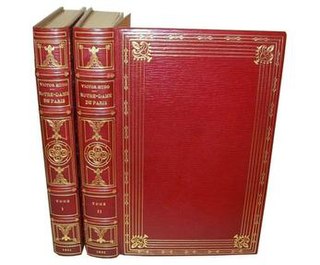
The Hunchback of Notre-Dame is a French Gothic novel by Victor Hugo, published in 1831. The title refers to the Notre-Dame Cathedral, which features prominently throughout the novel. It focuses on the unfortunate story of Quasimodo, the Roma street dancer Esmeralda and Quasimodo's guardian the Archdeacon Claude Frollo in 15th-century Paris. All its elements—the Renaissance setting, impossible love affairs and marginalized characters—make the work a model of the literary themes of Romanticism.

The Hunchback of Notre Dame is a 1996 American animated musical drama film produced by Walt Disney Feature Animation and released by Walt Disney Pictures. It is loosely based on the 1831 novel of the same name by Victor Hugo. The film was directed by Gary Trousdale and Kirk Wise and produced by Don Hahn, from a screenplay written by Tab Murphy, Irene Mecchi, Jonathan Roberts, and the writing team of Bob Tzudiker and Noni White. Featuring the voices of Tom Hulce, Demi Moore, Tony Jay, and Kevin Kline, the film follows Quasimodo, the deformed and confined bell-ringer of Notre Dame, and his yearning to explore the outside world and be accepted by society, against the wishes of his cruel, puritanical foster father Claude Frollo, who also wants to exterminate Paris' Roma population.
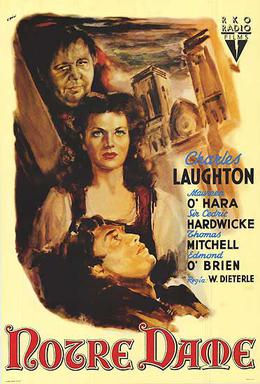
The Hunchback of Notre Dame is a 1939 American romantic drama film starring Charles Laughton and Maureen O'Hara. Directed by William Dieterle and produced by Pandro S. Berman, the film is based on Victor Hugo's 1831 novel. The film is also noted for being the first film ever shown at the Cannes Film Festival before the rest of the festival was cancelled due to the start of World War II.

Quasimodo is a fictional character and the main protagonist of the novel The Hunchback of Notre-Dame (1831) by Victor Hugo. Quasimodo was born with a hunchback and feared by the townspeople as a sort of monster, but he finds sanctuary in an unlikely love that is fulfilled only in death.
Clopin Trouillefou is a fictional character first created in the 1831 novel The Hunchback of Notre-Dame by French author Victor Hugo, and subsequently adapted.

Pierre Gringore was a popular French poet and playwright.
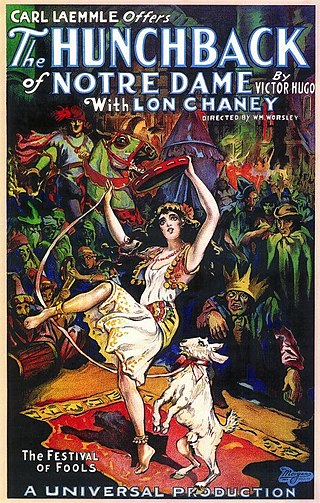
The Hunchback of Notre Dame is a 1923 American drama film starring Lon Chaney, directed by Wallace Worsley, and produced by Carl Laemmle and Irving Thalberg. The supporting cast includes Patsy Ruth Miller, Norman Kerry, Nigel de Brulier, and Brandon Hurst. Distributed by Universal Pictures, the film was the studio's "Super Jewel" of 1923 and was their most successful silent film, grossing $3.5 million. The film premiered on September 2, 1923 at the Astor Theatre in New York, New York, then went into release on September 6.
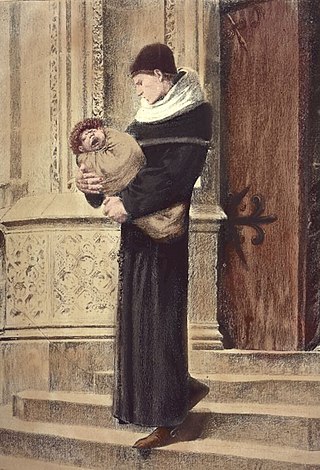
Claude Frollo is a fictional character and the main antagonist of Victor Hugo's 1831 novel The Hunchback of Notre-Dame. He is an alchemist and intellectual, as well as a Catholic clergyman.
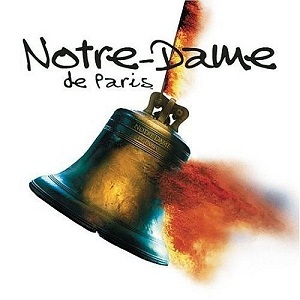
Notre-Dame de Paris is a sung-through French musical which debuted on 16 September 1998 in Paris. It is based upon the novel Notre-Dame de Paris by the French novelist Victor Hugo. The music was composed by Riccardo Cocciante and the lyrics are by Luc Plamondon.

The Hunchback of Notre Dame is a 1982 American romantic drama TV film based on Victor Hugo's 1831 novel. Filming location was Pinewood Studios, England. It was directed by Michael Tuchner and Alan Hume and produced by Norman Rosemont and Malcolm J. Christopher. It starred Anthony Hopkins, Derek Jacobi, Lesley-Anne Down and John Gielgud. The film was produced as part of the long-running Hallmark Hall of Fame series and was televised on CBS on February 4, 1982.

The Hunchback of Notre Dame is a 1956 French-Italian CinemaScope film version of Victor Hugo's 1831 novel, directed by Jean Delannoy and produced by Raymond Hakim and Robert Hakim. It stars American actor Anthony Quinn and Italian actress Gina Lollobrigida. The film is the first version of the novel to be made in color.

The Hunchback of Notre Dame II is a 2002 American animated musical film directed by Bradley Raymond. It is a direct-to-video sequel to Disney's 1996 animated feature film The Hunchback of Notre Dame. The film was produced by the Japanese office of Walt Disney Animation and Walt Disney Television Animation, while it was distributed by Walt Disney Studios Home Entertainment. Much of the actors from the original film reprise their roles, with the addition of new characters played by Jennifer Love Hewitt and Haley Joel Osment. Critical reception was mostly negative.
La Esmeralda is a ballet in three acts and five scenes, inspired by the 1831 novel Notre-Dame de Paris by Victor Hugo, originally choreographed by Jules Perrot to music by Cesare Pugni, with sets by William Grieve and costumes by Mme. Copère.

Esmeralda, born Agnès, is a fictional character in Victor Hugo's 1831 novel The Hunchback of Notre-Dame. She is a French Roma girl. She constantly attracts men with her seductive dances, and is rarely seen without her clever goat Djali. She is around 16 years old and has a kind and generous heart.

CapitainePhœbus de Châteaupers is a fictional character and the secondary antagonist of Victor Hugo's 1831 novel, Notre-Dame de Paris. He is the Captain of the King Louis XI's Archers. His name comes from Phoebus, the Greek god of the sun.
Judge Claude Frollo is a fictional character and the main antagonist of Disney's 34th animated film, The Hunchback of Notre Dame (1996). He was based on Archdeacon Claude Frollo from Victor Hugo's 1831 novel.
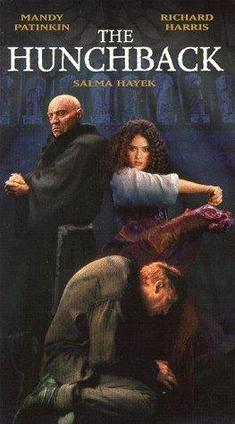
The Hunchback is a 1997 made-for-television romantic drama film based on Victor Hugo's iconic 1831 novel The Hunchback of Notre-Dame, directed by Peter Medak and produced by Stephane Reichel. It stars Richard Harris as Claude Frollo, Salma Hayek as Esmeralda and Mandy Patinkin as Quasimodo, the titular hunchback of Notre Dame.
The Hunchback of Notre Dame is a British feature length adaptation of the 1831 novel by Victor Hugo, produced for television by the BBC in 1976 and aired on December 30 the same year. Directed by Alan Cooke and written by Robert Muller, the film stars Kenneth Haigh as Claude Frollo, Warren Clarke as Quasimodo and Michelle Newell as Esmeralda, and features the visual effects by Ian Scoones and the original music by Wilfred Josephs.
Miss Esmeralda is a Victorian burlesque, in two acts, with music by Meyer Lutz and Robert Martin and a libretto by Fred Leslie, under his pseudonym "A. C. Torr", and Horace Mills. It is based on Victor Hugo's novel Notre Dame de Paris.

Esmeralda is an opera in four acts composed by Arthur Goring Thomas to an English-language libretto by Theo Marzials and Alberto Randegger based on Victor Hugo's 1831 novel The Hunchback of Notre-Dame. It premiered in London on 26 March 1883 at the Theatre Royal, Drury Lane with Georgina Burns in the title role and Barton McGuckin as her lover, Phoebus.